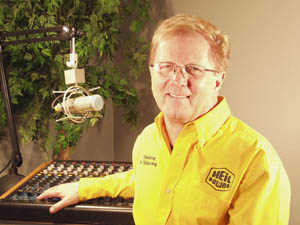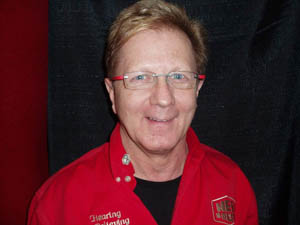Interviews with Bob Heil
Articles about Bob Heil’s work with the Who’s sound in 1971–1974.
From the Belleville (Illinois) News-Democrat, Tuesday, 9 May, 2006
Rock hall hails Heil’s wizardry
Metro-east native created equipment for stars | Slide show
By Scott Wuerz, News-Democrat
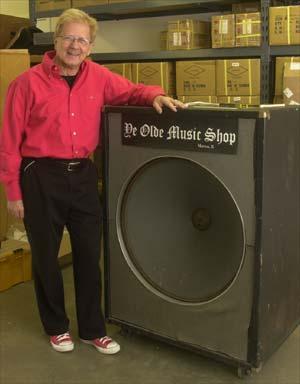
Bob Heil stands next to a speaker box with a 30-inch speaker. The sign is from Ye Olde Music Shop, his original store in Marissa, Il. Derik Holtmann/News-Democrat
The keen ear and technical know-how that put Bob Heil’s name in the Rolodexes of rockers Pete Townshend, Joe Walsh and Peter Frampton have landed his work in the Rock and Roll Hall of Fame and Museum.
A display of mixing boards, special effects machinery and speakers made by the metro-east resident and used by the biggest rock acts of the 1970s will be put on permanent display in the Cleveland museum June 8.
“This is something I have been putting together for about a year and half,” Heil said of the display. “There’s a lot of history in this equipment. I told the curator from the Hall of Fame that I would clean everything up really good for him and he freaked out. He told me not to clean or fix anything.”
Heil is a pioneering figure in the industry because he not only because he built the high-powered sound systems that made 1970s concerts the spectacle they were, according to Rock and Roll Hall of Fame curatorial director Howard Kramer. But also because he pioneered methods to make that A-bomb loud sound well articulated instead of just a wall of unintelligible noise.
“The concert business became what it is today because he made the experience so much better for the customers,” Kramer said of Heil. “No one made the leaps in live sound that he did.”
Heil, can pinpoint the date he made it in rock and roll. It was a fateful night in 1970 when he found himself on the opposite end of a phone line with Grateful Dead singer Jerry Garcia.
The psychedelic rock band arrived in St. Louis without its sound equipment and was desperately looking for something to borrow for a show at the Fox Theatre. In stepped Heil, who supplied a public address system complete with speakers, mixing board and microphones from his store, the Ye Olde Music Shoppe in Marissa.
“It was so much better than what they had, it blew them away,” Heil said. “They took my stuff on tour with them when they left for their next show.”
After that, luminaries of 70s rock and roll sought out Heil, who eventually relocated to Fairview Heights and changed the name of his business to Heil Sound.
The Who had him build a custom quadraphonic mixing board for the band’s 1974 Quadrophenia tour. The board, called MAVIS for Music and Voice Instrument System, along with a rear channel speaker from the tour, are the centerpieces of the Heil exhibit, according to Kramer.
Also included in the display are: A mixing board used to produce the sound for the legendary Mississippi River Festival and a fiberglass Talk Box, serial number 1, signed by Joe Walsh and Peter Frampton.
The Talk Box, which was invented by Heil, allows a guitarist to manipulate the sound of his instrument with his mouth.
“Joe wanted it for his song ‘Rocky Mountain Way,’ so I built it for him,” Heil said. “He made a sort of guttural sound with it. But Peter Frampton could actually talk through it.”
A microphone in the display used by The Who singer Roger Daltry is still wrapped in the 32-year-old red gaffer’s tape that Heil put on it to keep the mic from getting lost in the crowd.
“He would swing those things by the cord and the microphones would come loose and go flying,” Heil said of Daltry’s trademark stage move. “While everyone else was thinking ‘man, that looks cool’ I was thinking ‘Hey, that’s my microphone!’”
In case anyone questions the authenticity of the well-worn piece, Heil has hung from the microphone stand a photo taken during the tour of Daltry belting lyrics into the red-wrapped mic.
Most of the equipment that is going into the Hall of Fame was scattered around his garage in boxes, Heil said. But The Who’s mixing board was sold around 1980 when he grew disenchanted with the punk rock scene that took over rock music and got out of the business of engineering concert sound. A guy from Florida called him one day and offered to sell back the equipment, which was being used to prop up a broken bed frame.
While his equipment will be on display at the Hall of Fame, Heil was quick to point out that he isn’t being inducted into the Hall of Fame.
At this point, there is no category for sound engineers.
“But that’s OK,” Heil said. “That’s not why I got into this. We were just having a great time. I never expected all the attention I’ve had.”
Photo gallery from Bob Heil interview article in Belleville (Illinois) News-Democrat.

Derik Holtmann/News-Democrat Bob Heil stands next to a speaker box with a 30-inch speaker. The sign is from Ye Olde Music Shop, his original store in Marissa, Il.
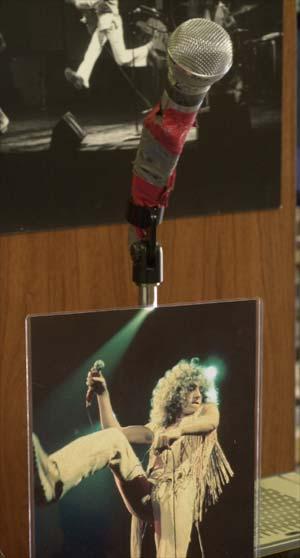
Derik Holtmann/News-Democrat Microphone, duct tape and all, used by Roger Daltrey for the Who’s Next tours, with photo of Daltrey using mic during a concert.
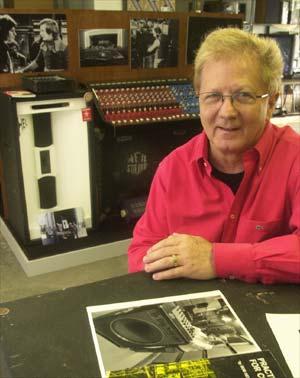
Derik Holtmann/News-Democrat Bob Heil with his technology that will be on display at the Rock and Roll Hall of Fame in Cleveland. In the background is the quad sound system mixer built for the Who’s Quadraphenia Tour and one of the rear surround speakers used during the 1974 tour.
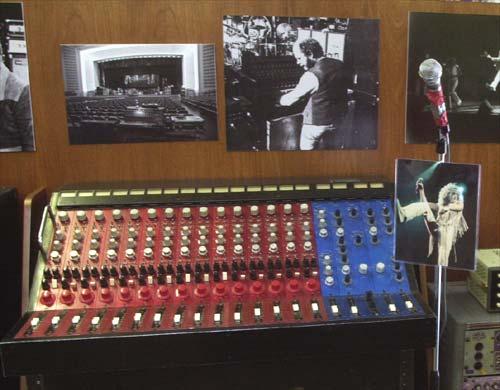
Derik Holtmann/News-Democrat The first quad sound system mixer that Pete Townshend asked Bob to build for the Quadraphenia tour.
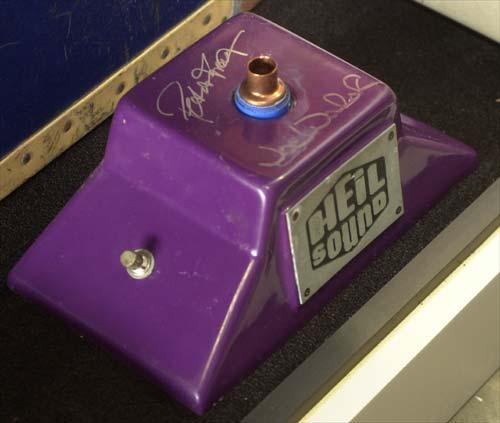
Derik Holtmann/News-Democrat Serial #1 Heil Talk Box created by Bob Heil and Joe Walsh and used on Walsh’s “Rocky Mountain Way.” Peter Frampton used it to record “Show Me The Way.” Signed by Walsh and Frampton.
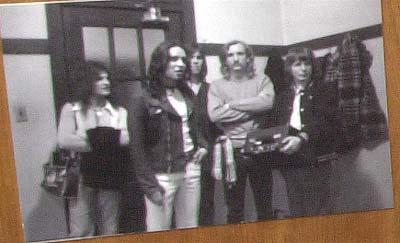
Special to the News-Democrat Bob Heil, right, with members of the James Gang.
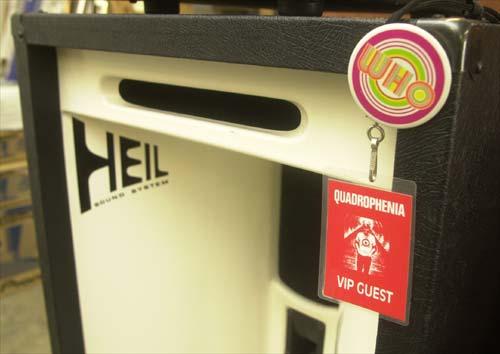
Derik Holtmann/News-Democrat One of the rear surround speakers used for the Who’s 1974 Quadraphenia tour.
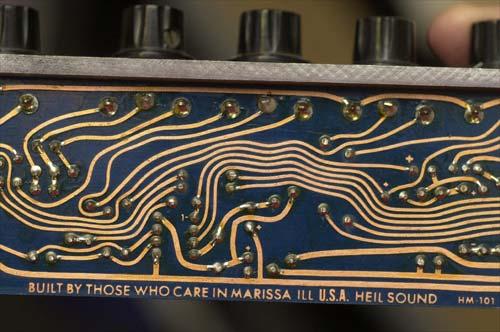
Derik Holtmann/News-Democrat Circutry from a mixer with the stamp “Built by Those Who Care in Marissa, Ill., U.S.A., Heil Sound.”
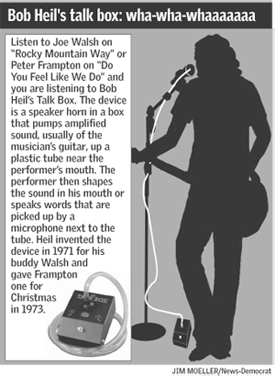
Jim Moeller/News-Democrat Bob Heil’s talk box: wha-wha-whaaaaaaa
From Musician’s Friend, May 2006:
Bob Heil: A Living Live-Sound Legend
Anyone who’s been to a rock concert in the past 40 years owes a huge debt of gratitude to Bob Heil. With the explosion of rock music in the 1960s came bigger concerts and bigger crowds that PA systems of the time simply couldn’t handle. Seeing the need for better live sound systems, Heil began experimenting and eventually created the first large-scale PA system. A chance meeting with The Grateful Dead put his system on the rock-and-roll map, where he continued to innovate live sound techniques throughout the ’70s with numerous acts like The Who, Humble Pie, and Peter Frampton. After leading the amateur radio market for the last 20 years with his broadcast mics, Bob partnered with his old friend Joe Walsh to create a new line of dynamic microphones suitable for the stage and studio. We caught up with Bob recently to discuss his legendary past, his contributions to the industry, his new PR Series microphones, and the Heil Sound Exhibit opening at the Rock and Roll Hall of Fame in June 2006.
- Musician’s Friend: Bob, tell us how you first got involved in pro audio.
Bob Heil: That’s a long story! First, let’s back up to the fact that when I was 15 I became a ham radio operator. I was building gear, designing stuff — things that hams do. But I also was pipe organist — a theater organist, not a church organist. I played at the Fox Theater here in St. Louis, and I learned to listen. That’s very important. Voicing and tuning Wurlitzer pipe organs is an art, and I was very fortunate to learn how to voice those things. Those two skills made it possible for me to do what I have done.
I played for about 12–14 years at the Fox, and I figured that it was time to do something else. So in 1966 I came back to my little hometown of Marissa — 2,500 people in the middle of southern Illinois — and I opened up a little music shop and sold Hammond organs. I wasn’t into rock-and-roll. I paid attention to the music of the ’20s and ’30s, which is what I played. What happened was I started renting Hammond organs to the rock groups who came through St. Louis. Nobody was doing that; Hammond organ dealers thought, “We’re not gonna rent these freakos an organ.” Then I’d get on these stages, and they’d have all kinds of problems. So I started fixing things for them.
Then I noticed their PA systems sucked. They had these little bitty columns! So I built this monster sound system. The Fox Theater was throwing out a couple of A4s. These are speakers that fill up the back of a truck — huge speakers! I took those and built this monstrous PA with a bunch of McIntosh amps. And that’s what started the whole sound revolution.
The Grateful Dead came through town around 1971, and they didn’t have a PA. Theirs was confiscated the night before by the feds because they weren’t supposed to go out of California. Anyway, they show up at the Fox Theater. The Fox calls me and hands the phone to Jerry Garcia. He says, “You got a PA, man?” I said, “Yeah, I’ve got A4s, a whole bunch of McIntoshes.”
So I took it up there and we changed the world that one night. They freaked out. They took me right out on tour — right out of the theater that night off to New Jersey. Then it hit the front page of Billboard magazine that we had got the Grateful Dead contract, and the next thing you know, The Who is calling me, ZZ Top, Humble Pie, on and on.
Shortly after that I met Joe Walsh. We were doing sound for the James Gang with this monster sound system. Well, Joe’s a ham (radio operator)! So he and I went nuts. We started wiring things and doing stuff and making the James Gang louder and bigger and better. But we weren’t paying attention to the fact that we were changing the world. We were doing this because Joe needed it done. That was the catalyst that got me into this. Then it was like a passion. We designed the first electronic crossover, we did the first parametric equalizer, we did the first modular console, the first modular power amps. We were the first guys to use fiberglass. It just went nuts from there. We had 35 people working in our little plant there in Marissa building all kinds of gear. Some of it’s still being used. I’m amazed that stuff is still out there after all these years. But it was that good. It was really a wonderful ride, because I was helping people. It all started from that love of ham radio and learning to listen when voicing those pipe organs.
- MF: So basically rock-and-roll took the PA systems of the time by surprise. They just weren’t designed to handle that kind of sound and volume.
BH: Absolutely. Everyone was playing little Fender Twins and stuff like that, and using a little column with four speakers in it for a PA system. All of a sudden here comes the Vox Beatle, the Marshalls, the big 100- and 200-watt guitar amps that would just blow the PA away. You couldn’t even hear the vocals. That came on much faster because nobody was doing anything in the sound reinforcement business.
Here we came at the right time, experimenting and not afraid to try anything, whereas a corporate company would say, “Well, our design engineers will have to do a study on this . . . ” Bulls**t! I’ve got 20,000 screaming kids out here that can’t hear Garcia’s vocals! You better get this thing working! We had to do it right now! Thank God that the ham radio operators in us could do it. I didn’t need any schematics or corporate studies. All I needed was my soldering iron! (Pete) Townshend always put it kinda cool. He’d say, “Leave him alone, leave him alone. He’s got a soldering iron, he can make it sound better, and he can drive the truck!” (Laughs)
- MF: How did you get involved with The Who?
BH: They hadn’t been here in several years; since the late ’60s. During that time, the level of concert sound quality came way up. They came over here with their little columns, like VocalMasters, if you remember what those were. Just little columns with four speakers in them. They had about six of these across the front of the stage. Think about that. Think about that. The Who playing through these little mixers with eight channels on them, and these little columns. The guitar amp was louder than that!
They came over (to the US) to do this huge tour, Who’s Next, and they miserably bombed the first night. It was terrible. So their manager had heard about this sound system. We were working with Sunn — I was their largest dealer — and I was doing design work for them. We had just put together this monster system for Sunn. We hand-built this console, all point-to-point wiring.
So we were on tour with Wild Cherry in Chicago. The Who’s people called Sunn because they’d heard about me and this sound system.
Sunn called me and said, “You have to get to Boston.”
I said, “Yeah, OK. When?”
“Tomorrow.”
I said, “Well, I’m on tour.”
They said, “We don’t care, we want you to get there.”They told me to rent an airplane if I had to. So we did, we rented a Tiger 707! Tiger was an air freight company back in those days in Chicago. I called a buddy of mine to come finish the Wild Cherry tour, and we flew all that stuff out to Boston. We set it up for soundcheck and blew them (The Who) out on the street. They’d never heard anything like it, and it changed the whole direction of The Who. Townshend was freaking out because they’d never heard anything that good, that loud, that big.
We did two complete tours, I think 36 dates each, then we went to England and toured over there. We played for about 200,000 kids in a cricket oval! From there we did some European dates, then came back here for more American dates with Who’s Next.
- MF: Is it true that Pete asked you to build a quad PA for the Quadrophenia tour?
BH: Well, after we finished Who’s Next, this would have been about ’73, he called me one day and said, “I need to talk to you, so come over here (to England).” So I got on a plane and went to London.
Pete said, “I’m hearing this thing with four guys, one in each corner. Do you think you could build a PA so we could move Roger’s voice around the arena?” I said, “Yeah, we’ll have to put some speakers in the back but we can do that.” He said, “You go build it, I’m gonna go write it.” He knew that we could make it sound good and that’s what we did.
That system will be the centerpiece of the Rock-and-Roll Hall of Fame display that opens in June.
- MF: Tell us more about the exhibit.
BH: I’m very, very honored by this and extremely humbled. They decided that Heil Sound was one of the leading designers and builders of technical things that changed the direction (of rock-and-roll). We actually found that console (from Quadrophenia). The guy that had it read on the Internet that this thing with the Rock Hall was festering, and he called me last year. I had sold it to him back in 1980, and I just totally forgot about where it went.
We’re getting it all together, and in June this display will open in Cleveland with that, one of Roger Daltrey’s microphones, one of Townshend’s guitars, some of the fiberglass horns, one of the speakers that was used for the rear channels of Quadrophenia, some of the power amps we built, the parametric EQ we built — all those early things. The Sunn mixer that we hand-built and used for Who’s Next will be there too.
- MF: Looking back, what are the most important things you’ve learned about sound?
BH: I was honored to have Paul Klipsch, the guy who almost singlehandedly brought hi-fi to the world, call me up around ’72 or ’73. He wanted to come to Marissa to see what I was doing, so he flew up and spent the day with me. I had this monster 30,000-watt system. He was floored. He had never seen that many power amplifiers before and such a waste of power. He was really an efficiency bug.
So he put me in his plane and flew me down to Hope, Arkansas, where he lived. He taught me more stuff than a college education. I came back home and my 30,000-watt system became 10,000 watts. And it was louder, cleaner, and more articulate with a third the power. Just because he taught me how to load speakers in a cabinet, about the efficiency of speakers, and about articulation. He introduced me to the Fletcher-Munson Curve. Fletcher and Munson figured out how our ears work, and that our ears are far from flat. If you know about the Fletcher-Munson Curve of the human ear, you can adjust the sound system to make up for those little deficiencies and bingo — articulation comes alive! Everything I’ve done in my career has been about articulation. Very few people even understand what that word means.
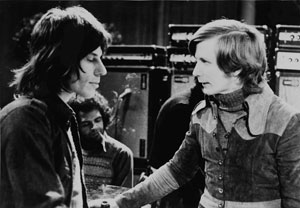
Bob Heil with Jeff Beck
- MF: Who are some of the artists you’ve worked with over the years?
BH: Joe Walsh and the James Gang, The Grateful Dead, The Who, Jeff Beck, ZZ Top, Humble Pie, Peter Frampton, The Eagles, Seals & Crofts, Bachman-Turner Overdrive, Leslie West, J. Geils, Ike & Tina Turner, B.B. King, Chuck Berry. Those are a few of the biggest.
- MF: You invented one of the most famous guitar effects ever. Tell us how the Heil Talk Box came to be.
BH: Joe Walsh had recorded “Rocky Mountain Way” using an 8″speaker and a funnel, a device used in Nashville by the steel guitar players. Well, it wasn’t very loud so you couldn’t use it live. So here we are, two ham radio operators on a Sunday afternoon out in my plant. We grabbed a 250-watt JBL, built a low-pass filter, got all the plumbing together, and voila — the Talk Box. That’s how it started. After that tour, everybody’s going nuts! “What’s this thing he’s got?” So I put together a commercial unit called the Heil Talk Box. Then Peter Frampton’s girlfriend Penny called me wanting a Christmas present for Peter. So I sent a Talk Box. The rest of the story writes itself from there.
The first 50 were done in fiberglass, and Peter still carries his fiberglass one today. When you see him, somewhere in his gig box is that original Heil Talk Box. I have serial number 1 that will go in the Rock Hall with Peter and Joe’s signatures.
- MF: Why did you decide to start building microphones?
BH: I got pretty tired of the music business around 1980. Moonie (Keith Moon) had died, my big acts were off the road. Punk rock was the direction that music was going, and there was no challenge for me in that, so I quit.
I hadn’t been on the ham radio airwaves for about 10 or 12 years, so I started listening around. I thought, “What the hell happened here?” All the audio was really mushy with no articulation. So I started playing around, and I built some very exotic microphones. I went back and thought about the things that Paul Klipsch and I talked about, and I built this amazing little microphone element that had a labyrinth in it. Some of the engineers I talked to were, like, “You’re out of your mind, you can’t do that.” But 100,000 units later we own the amateur radio market with it. It’s not pretty sounding, but it’s articulate. That’s what it’s meant to be.
Anyway, a couple of years ago, I’m standing in Joe Walsh’s kitchen and he hands me one of the Heil Amateur Radio mics I gave him and asks me to put an XLR jack in the bottom of it. I asked him why and he said the microphones The Eagles were using didn’t have any articulation!
I came back home and thought, “I can do something better.” A lot of companies had moved their plants to Mexico and China, and they weren’t producing the same microphones I knew in 1975. So Joe and I started in and, well, we built a mic that’s absolutely blowing people away. Not one oscilloscope, not one analyzer, no computer modeling — nothing like that was used to design it. Just four 10″ JBL speakers and my ears. Once I believed I got it right, I’d send it to Joe and he would listen to it in his studio and then take it onstage (with The Eagles). Who else can have The Eagles as their beta tester? That’s how the new Heil PR Series was designed. Not only did I build it for Joe, I built it for the world. And it’s everywhere we look now — from David Letterman’s desk all the way to whatever!
- MF: Why are Heil mics so different from other mics out there?
BH: Big diaphragms, new technology, and new materials. You go buy a microphone today, I don’t care what kind, and they’ve all got little 3/4″–7/8″ diameter cartridges in them. My PR-30 has an inch-and-a-half diaphragm! The bigger it is, the more articulation we can get out of it, the more dynamic range we can get out of it, the better the proximity effect. Everything works better because it doesn’t have to work as hard. So we get less distortion, the phasing is easier to maintain, and things just work better overall.
- MF: Can Heil mics be used for recording as well as live sound?
BH: Absolutely. We wanted these mics to transcend application. If I make them work right, they work right for a wide variety of things. Live sound, radio broadcast, recording, podcasting — you name it. I never dreamed it would actually happen but I’ve been in a lot of recording studios lately. I just did some things with Adam Jones and Tool, Joe Baressi, Converge, and Unearthed. It’s refreshing to see them being used in the recording world by guys that are out there who really care a lot about tone and the way things sound.
- MF: What do you recommend as far as microphones go for someone building a home recording setup on a budget?
BH: The first thing you have to do is learn to listen. Hearing is a physical process; listening is a mental process that you have to learn, comparing one sound to another, choosing the best of the two, or best of the three. In the recording world, listening is everything. So you have to listen to what you’re buying. The next thing you need is a really good vocal microphone, because everything is centered around a vocal. People look for the cheapest price but that doesn’t make for good vocals. You don’t want to do that. Listening will lead you to performance. Our PR-20 is a great mic for vocals, studio or live — that’s the one that Joe Walsh helped me get started with. It looks like a handheld but has amazing fidelity. We also make the PR-30 mic, one that is equally at home live or in the studio. It’s great for guitar amps, acoustic guitars, or warm-type applications where you might want a ribbon but can’t afford one, or you need something more durable. Our widest bandwidth mic is the PR-40. It’s a large diaphragm mic that sounds like many condensers but doesn’t need a power supply or special care. For the money, Heil mics put you ahead of the pack because the fidelity is so much wider than a normal dynamic microphone.
- MF: In a live sound setup, how would you rank the importance of the components that are used in the overall sound?
BH: Well, you’ve got a chain: a microphone, mixer, signal processing, power amps, speakers and horns. I recommend that you focus on transducers — things that change energy from one form to another. Spend the most on speakers with the right power amps. The speakers are one of two system transducers. After you’ve got the right speakers, don’t buy cheap mics! Microphones are the other transducer in the system and the sound of the PA starts with the mic and ends with the speakers. Cheap mics lack vocal definition and have poor articulation, and you can’t fix that with any kind of speaker, mixer, or signal processing. Remember, you can’t fix acoustical problems (like bad mics) with electrical solutions (like a mixer). Start with great transducers and go from there.
Bob Heil’s remarkable contributions to Rock-and-Roll will be honored with the opening of a technology display featuring some of Bob’s early Heil Sound designs at the Rock-and-Roll Hall of Fame in Cleveland, Ohio, this June. Be sure to enter the Musician’s Friend Rock-and-Roll Hall of Fame Sweepstakes for a chance to attend and hang out with Bob himself!
